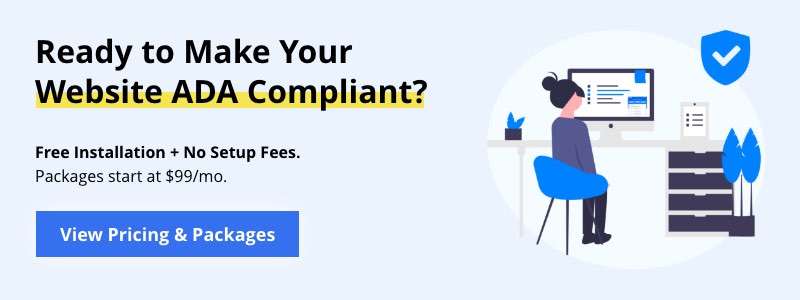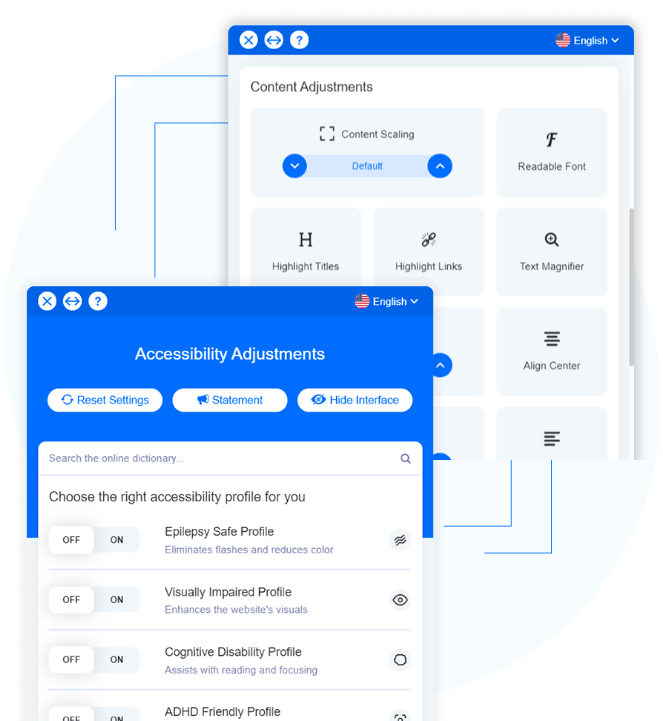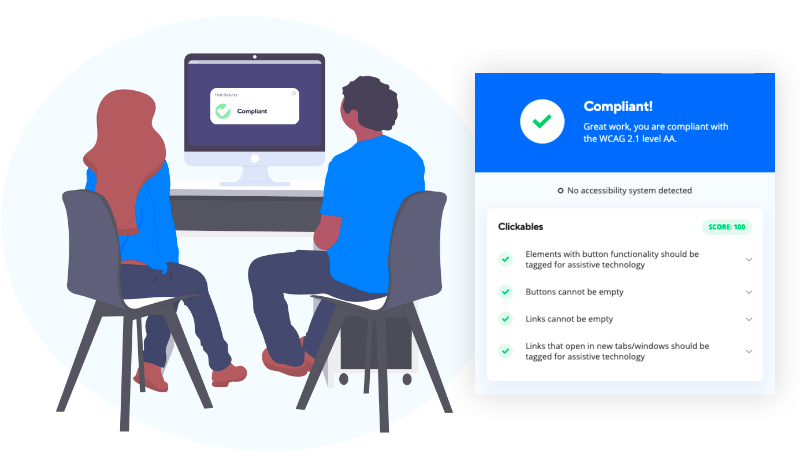Introduction
Did you know that all business-related websites are now considered places of public accommodations and must be accessible for people with disabilities – also known as ADA website compliance? Let’s say you have this awesome website that you love. And better yet, it looks beautiful and works great. But did you know that it’s likely not working for people with disabilities, which accounts for over 20% of the population? And even worse, you’re opening yourself up to potential lawsuits which have increased 300% since 2018?
Well it’s a good thing you’re reading this article because we’re going to give you a comprehensive look at ADA website compliance, why it matters, and what you can do to make sure your website is friendly for everyone.
Quick Video Overview
Before we begin, watch the video below for a quick overview on web accessibility, ADA compliance, and WCAG guidelines.
What is the ADA?
The ADA, or the Americans with Disabilities Act, was signed into law over 30 years ago in 1990. The ADA is most well known for leaving its handprint on every building across the United States of America, making it a mandatory requirement for businesses and government organizations to include wheelchair-accessible ramps. Modeled after the civil rights act of 1964, this comprehensive piece of legislation prevents businesses from discriminating against people with disabilities and it guarantees that people with disabilities “have the same opportunities as everyone else to participate in the mainstream of American life — to enjoy employment opportunities, to purchase goods and services, and to participate in State and local government programs and services.” (ada.gov)
How Does ADA Affect My Business?
It goes without saying that times have changed, and so have the ways in which one participates in the mainstream of American life. Brick-and-mortar shopping, banking, and many other day-to-day activities continue to mobilize towards the internet, making it essential for businesses to have easily accessible websites for all. Especially in the wake of a global pandemic where people are forced to work, learn, and entertain themselves online, American life, more than ever before, exists on the internet. As is such, in 2010 the department of justice revised Titles II and III of the ADA to include access to online services. This requires governments and commercial organizations to meet the Americans with Disabilities Act standards for accessible design, which mandates all electronic and information technology, like websites, be accessible to those with disabilities.
Therefore, websites that contain significant components of inaccessibility can be seen as discriminatory towards people with disabilities and in violation of the ADA. In contrast, a website that is in compliance with the ADA creates a more user-friendly platform for all users, including those visitors with limitations or disabilities such as/but not limited to:
- Blindness
- Low vision
- Learning disabilities
- Cognitive disabilities
- Deafness
- Hearing loss
- Speech disabilities
- Physical disabilities
What Does Website ADA Compliance Mean?
Although there aren’t any clear ADA directions as to what a compliant website should look like, businesses and organizations that are subject to the ADA are required to offer web content that is reasonably accessible to people with disabilities. Among other things, web content should be easily accessed by those who must navigate the internet by voice, screen readers, or other assistive technologies. There are no enforceable laws for website accessibility (unless you run a government website), however, failure to meet these standards can result in lawsuits, financial liabilities, and damage to your brand image and reputation (as well as the loss of potential clients or customers!).
How Can I Tell if My Website is ADA Compliant?
The ADA does not offer explicit guidelines for website compliance, which makes it difficult to know whether you are in the clear with these regulations. To offer assistance and a reference point to businesses and organizations that fall under the ADA regulations, the World Wide Web Consortium, or W3C, created the Web Content Accessibility Guidelines (WCAG). Although these aren’t legal requirements, the WCAG serves as a benchmark for web accessibility to organizations looking to make their website useful to all users. The WCAG defines a compliant website as one that is perceivable, operable, understandable, and robust.
- Perceivable: Defined by W3C, “Information and user interface components must be presentable to users in ways they can perceive.” A website must not favor any one sense namely sight, sound, or touch. Within the perceivable guidelines, it is recommended that organizations “provide text alternatives for any non-text content so that it can be changed into other forms people need, such as large print, braille, speech, symbols or simpler language.” Alternatives for time-based media should be provided. This could include audio-only and video-only pre-recorded media, pre-recorded captions, audio descriptions, live captions, sign language, or other pre-recorded media alternatives. In order to be considered perceivable, websites should be adaptable. The WCAG recommends creating content that can be presented in different ways (for example simpler layout) without losing information or structure. Finally, a perceivable website is distinguishable, making it easier for users to see and hear content including separating foreground from background.
- Operable: Can your users navigate their way through your website without missing out on anything? Websites should be fully functional with the sole use of a keyboard interface, there should be no timing limitations or “enough time” provided to read and use the web content, and content should not be designed in a way that is known to cause seizures or other physical reactions. Your website should be navigable with sequence and proper titles and headlines in mind. Users should also be able to operate with the use of various inputs beyond keyboards like pointers or motion actuation.
- Understandable: The content and text on your website should be readable, and when unreadable due to unusual words or abbreviations there should be a mechanism to define that content. In order to be understandable, your website should be predictable without any unexpected change of context. An understandable website helps users avoid mistakes and corrects them if they do make a mistake.
- Robust: “Content must be robust enough that it can be interpreted by a wide variety of user agents, including assistive technologies.” A robust website works with all web browsers, assistive technologies, and alternative ways to access your web content and it meets recognized standards like using clean HTML or CSS.
Who is Subject to ADA Website Compliance?
Not all businesses are subject to comply with the ADA requirements. If your organization falls under Title I or Title III of the ADA, you are subject to the regulations. Title I covers private employers who have 15 or more full-time employees for at least 20 calendar weeks who are engaged in an industry that affects commerce. Title III focuses on private and public entities that are considered public accommodations. This includes state and local governments, and basically any business that regularly serves the public (does the public enter your establishment regularly?). Organizations exempt from these regulations include businesses operating under the 15 employee standard, private clubs, religious establishments, or businesses owned by a federally recognized native Reserve. However, this does not necessarily prevent someone from bringing a lawsuit against your business.
Why Should My Website be ADA Compliant?
If your business falls under Titles I or III of the ADA, it goes without saying that you are legally obligated to make your website reasonably accessible for all users. If you are in violation of these standards, you open yourself up to the risk of being sued. These legal fees can accumulate quickly, and to the tune of $50,000 or more. Of the more prominent class-action suits, Beyonce Knowles was sued for violating the ADA by denying visually impaired users equal access to the content of her website. Target corporation was sued for the same reasons in 2006 with a settlement of $6 million in damages and another $3 million in legal fees.
Not all businesses are subject to ADA compliance, however, the benefits of having a website that is reasonably accessible greatly outweigh the costs. The CDC estimates that over 61 million adults or 1 in 4 Americans live with a disability. That is roughly 26% of the US population who may very well exhibit the behaviors that align with your desired target market. When these users visit your website, and the necessary features aren’t available for them to navigate or understand your web content, you immediately lose out on perfectly warm leads. Now you have drastically limited the size of your target audience, losing out on a large sum of potential sales. Having a website that is easily navigated and experienced by all users will increase your potential audience and prevent you from losing sales opportunities.
Additionally, having an ADA compliant website assists in your Search Engine Optimization rankings. Because of specific ADA requirements like accurate and descriptive alt text, transcripts, meta tagging, and headings, an ADA-compliant website makes it easier for search engines to crawl and index your website. These features naturally push your web content further up in the search engine, placing you in front of more potential users. You are not only creating an accessible space for all, but you are subsequently driving more general traffic to your website.
Most importantly, it is the right thing to do. Everyone, no matter their ability or background, deserves an equal and fair opportunity to participate in the mainstream of American life and that life is undoubtedly online. The goal of your company should be to ensure everyone has fair and equal access to your web content. Web guru Neil Patel hits it on the head when he says:
“Brands that go the extra mile to implement accessibility, even when they aren’t required to, show their audience they care about people, not just profits. A commitment to your audience says a lot about your brand and the values you hold as a company, which can help strengthen the relationship with your customers.” – Neil Patel
A website that is accessible to all greatly enhances the user experience for everyone who visits your web content, including those with disabilities or limitations. Taking the needed time, energy, and monetary investment to create an accessible space for all will ultimately benefit your organization in the long run. Showing your users, potential customers, or visitors that you care for them and they are valued will only beget loyal customers who advocate for your brand. As the world continues to migrate towards an online existence, becoming ADA compliant is now a critical step in the sustainability of your website and organization.
How Do I Begin the Process of becoming ADA Compliant?
The process to becoming ADA compliant can seem overwhelming. The reality is, creating an ADA compliant website is strenuous and tedious work. There are, however, software tools available to assist you in identifying the steps you need to take to start this journey to a more accessible website. The World Wide Web Consortium provides a list of web accessibility evaluation tools to assist you in identifying where your website falls short of compliance, you can access that list here.
If you are manually updating your website, these tools will help guide you through each step of the development process, providing automated checks as you complete compliant updates. These tools, although useful, should not be your only source of direction when updating your website. Because there aren’t explicit and clear rules, these software tools can often produce false or misleading results. The tools are meant to assist you in accessibility, but they do not determine accessibility. Determining fully compliant accessibility requires human judgment.
Manually building an ADA compliant website can present risks to your organization. Thankfully, there are professionals who can identify where your website does not fully comply with the ambiguous ADA regulations. These professionals can also do
the tedious work of making your web content reasonably accessible to all users.
Web Accessibility Packages
The good news is we have a web accessibility packages to help get your website 96% ADA & WCAG compliant. We’ll install a widget on your website, fix any issues, and send you a monthly report showing your compliance. We’ll also provide you with accessibility statements, and certificates so you can prove historical compliance.
If you are uncertain as to whether your website is reasonably accessible, or if you know your website needs to be updated to comply, you can reach out to Sproutbox for a free web accessibility report.



